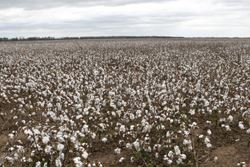|
China’s Cotton Cache, Appetite For Sorghum Helps Shift U.S. Acres
JONESBORO, ARK.
China’s cotton cache and its appetite for grain sorghum may have a heavy hand in Arkansas’ disappearing cotton acres.
Estimates for 2015 from the National Cotton Council estimate cotton planting in Arkansas to be down nearly 40 percent to a record low of 203,000 acres. The estimate is based on a survey of cotton growers conducted from mid-December to mid-January.
“We have data for planted acres back to 1909 and harvested acres back to 1866. Our all-time low was 310,000 in 2013,” said Bill Robertson, extension cotton agronomist for the University of Arkansas System Division of Agriculture. “Prior to that was 1983 at 320,000 and was a result of the Payment-in-Kind program.”
PIK was aimed at reducing production and provided incentives for growers to keep acreage idled.
Repeating cycle
Robertson also delved into the data to see if there had ever been a drop this large. The last time was during the decade of disco and polyester everything.
“We dropped 42 percent between 1974 and 1975,” he said. “1975 was the first year a producer was allowed to plant and market rice without a rice allotment” allowing some cotton acres to turn to rice.
The “bottom line: we have seen some big swings in acres in the past,” Robertson said. “Cotton will be back. Maybe not to the million-acre mark, but somewhere between that and half a million.”

Wide shot of defoliated cotton field in Lonoke County, Arkansas. 2011 file photo.
U of Arkansas System Division of Agriculture photo
Scott Stiles, extension economist for the University of Arkansas System Division of Agriculture, said that the “recent National Cotton Council survey reflects the significant headwinds the cotton market faces going into 2015.
“The global supply of cotton is at record levels and world cotton production has exceeded demand for five consecutive years,” he said.
In February, the USDA projected that world cotton ending stocks will be almost 110 million bales at the end of July this year.
“That is practically one year of global mill use sitting in reserve,” Stiles said. “Ample supplies on the world and U.S. balance sheet will certainly limit price upside through the spring.”
China’s stockpiles
One reason for the market standstill is China’s penchant for accumulating cotton. Stiles said that 58 percent of the 110 million bales of world cotton stocks are held by China, “our longtime largest export market.”
China’s stockpile means there’s little need for that country to import more.
“In 2011, China’s cotton imports reached a peak of 24.5 million bales. For the current marketing year, China’s imports are expected to be just 7.3 million bales,” he said.
“The U.S. has to compete for this much smaller Chinese market with India, Australia and Brazil to name a few,” Stiles said, adding, “Keep in mind, exports represent 75 percent of total demand for the U.S. cotton industry.”
Markets: grain vs. cotton
The grain markets also have a hand in the shaping of cotton’s acres this year.
“A year ago with December futures prices near 80 cents ahead of planting, we did see cotton acreage in the state increase some,” Stiles said. “Today, December 2015 futures trade near 65 cents. To compete with corn, soybeans and grain sorghum, cotton prices need to move to above 70 cents.”
“Given the ample supply situation that we have in the world and the U.S., it doesn’t appear today that the futures market is going to move to that price level prior to planting and send a signal to growers to maintain their cotton acreage,” he said.
Once again, China is helping to shift this balance, being “the top market for U.S. grain sorghum this year and accounts for about 80 percent of U.S. export sales,” Stiles said “While cotton sorts out its over-supply problem, our growers are well-positioned to shift acres and resources to this crop to meet this surge in export demand.”
Evaporating infrastructure
Gin closure and consolidation has been occurring for decades, but the potential loss of 100,000 acres or more this year will no doubt be felt by the remaining gins, warehouses, equipment dealers and input suppliers.
“From a longer-term perspective, the loss of industry infrastructure makes it more likely that cotton production in the state may not recover to the levels of a decade ago,” Stiles said. (See: http://www.uaex.edu/media-resources/news/may2014/05-22-2014-Ark-Silent-Gins.aspx)
“Farming has its unique barriers to entry and high fixed costs are certainly one of those barriers,” he said. “ This is especially true in cotton production when you consider harvesting machinery – it has one function and one huge price tag.”
Stiles said that at winter production meetings with farmers, he’s heard of more growers getting rid of cotton equipment.
“The key to rebuilding cotton’s infrastructure is a return to profitability,” he said. “Given the market fundamentals that exist today, we could be two to three years from seeing what may resemble a cotton resurgence.” ∆
|
|